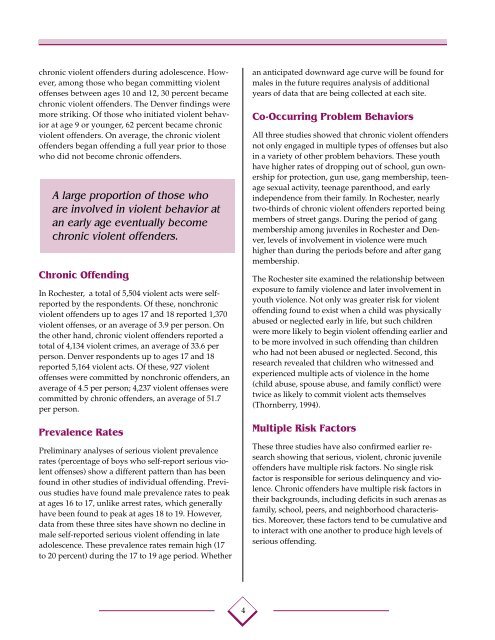uide for Implementing the Comprehensive Strategy for Serious ...
uide for Implementing the Comprehensive Strategy for Serious ...
uide for Implementing the Comprehensive Strategy for Serious ...
Create successful ePaper yourself
Turn your PDF publications into a flip-book with our unique Google optimized e-Paper software.
chronic violent offenders during adolescence. However,<br />
among those who began committing violent<br />
offenses between ages 10 and 12, 30 percent became<br />
chronic violent offenders. The Denver findings were<br />
more striking. Of those who initiated violent behavior<br />
at age 9 or younger, 62 percent became chronic<br />
violent offenders. On average, <strong>the</strong> chronic violent<br />
offenders began offending a full year prior to those<br />
who did not become chronic offenders.<br />
A large proportion of those who<br />
are involved in violent behavior at<br />
an early age eventually become<br />
chronic violent offenders.<br />
Chronic Offending<br />
In Rochester, a total of 5,504 violent acts were selfreported<br />
by <strong>the</strong> respondents. Of <strong>the</strong>se, nonchronic<br />
violent offenders up to ages 17 and 18 reported 1,370<br />
violent offenses, or an average of 3.9 per person. On<br />
<strong>the</strong> o<strong>the</strong>r hand, chronic violent offenders reported a<br />
total of 4,134 violent crimes, an average of 33.6 per<br />
person. Denver respondents up to ages 17 and 18<br />
reported 5,164 violent acts. Of <strong>the</strong>se, 927 violent<br />
offenses were committed by nonchronic offenders, an<br />
average of 4.5 per person; 4,237 violent offenses were<br />
committed by chronic offenders, an average of 51.7<br />
per person.<br />
Prevalence Rates<br />
Preliminary analyses of serious violent prevalence<br />
rates (percentage of boys who self-report serious violent<br />
offenses) show a different pattern than has been<br />
found in o<strong>the</strong>r studies of individual offending. Previous<br />
studies have found male prevalence rates to peak<br />
at ages 16 to 17, unlike arrest rates, which generally<br />
have been found to peak at ages 18 to 19. However,<br />
data from <strong>the</strong>se three sites have shown no decline in<br />
male self-reported serious violent offending in late<br />
adolescence. These prevalence rates remain high (17<br />
to 20 percent) during <strong>the</strong> 17 to 19 age period. Whe<strong>the</strong>r<br />
4<br />
an anticipated downward age curve will be found <strong>for</strong><br />
males in <strong>the</strong> future requires analysis of additional<br />
years of data that are being collected at each site.<br />
Co-Occurring Problem Behaviors<br />
All three studies showed that chronic violent offenders<br />
not only engaged in multiple types of offenses but also<br />
in a variety of o<strong>the</strong>r problem behaviors. These youth<br />
have higher rates of dropping out of school, gun ownership<br />
<strong>for</strong> protection, gun use, gang membership, teenage<br />
sexual activity, teenage parenthood, and early<br />
independence from <strong>the</strong>ir family. In Rochester, nearly<br />
two-thirds of chronic violent offenders reported being<br />
members of street gangs. During <strong>the</strong> period of gang<br />
membership among juveniles in Rochester and Denver,<br />
levels of involvement in violence were much<br />
higher than during <strong>the</strong> periods be<strong>for</strong>e and after gang<br />
membership.<br />
The Rochester site examined <strong>the</strong> relationship between<br />
exposure to family violence and later involvement in<br />
youth violence. Not only was greater risk <strong>for</strong> violent<br />
offending found to exist when a child was physically<br />
abused or neglected early in life, but such children<br />
were more likely to begin violent offending earlier and<br />
to be more involved in such offending than children<br />
who had not been abused or neglected. Second, this<br />
research revealed that children who witnessed and<br />
experienced multiple acts of violence in <strong>the</strong> home<br />
(child abuse, spouse abuse, and family conflict) were<br />
twice as likely to commit violent acts <strong>the</strong>mselves<br />
(Thornberry, 1994).<br />
Multiple Risk Factors<br />
These three studies have also confirmed earlier research<br />
showing that serious, violent, chronic juvenile<br />
offenders have multiple risk factors. No single risk<br />
factor is responsible <strong>for</strong> serious delinquency and violence.<br />
Chronic offenders have multiple risk factors in<br />
<strong>the</strong>ir backgrounds, including deficits in such arenas as<br />
family, school, peers, and neighborhood characteristics.<br />
Moreover, <strong>the</strong>se factors tend to be cumulative and<br />
to interact with one ano<strong>the</strong>r to produce high levels of<br />
serious offending.

















